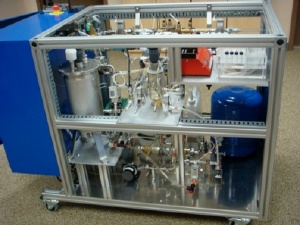Apr 17 2009
Early WarningTM today displayed its Biohazard Water Analyzer which offers the next generation in microbial testing. Using a unique combination of advanced technologies, the Analyzer goes beyond lab culturing of indicator coliforms and directly measures individual species of pathogenic bacteria, protozoa and viruses in the same test.
 Nanotechnology-Based Biosensor" />
Nanotechnology-Based Biosensor" />
The Analyzer employs a revolutionary nanotechnology-based biosensor exclusively licensed from NASA's Ames Research Center in Moffett Field, California and an on-board concentrator that processes a 10 liter water sample. The sample-to-report time is about 2 to 3 hours, and allows rapid prevention measures to be enacted. There is no need for time-intensive processes like transporting a water sample to the lab or Polymerase Chain Reaction (PCR). The Analyzer can be used as a transportable testing device or as a sensor node in a fully automated field sensor network.
"Biohazard outbreaks from pathogens and infectious diseases are responsible for the bulk of the 18.4 million deaths worldwide from communicable diseases estimated by the World Health Organization," said Neil Gordon, Early Warning's CEO. "Outbreaks occur every day in the U.S. and throughout the world from E.coli bacteria, Giardia and Cryptosporidium protozoan parasites, Vibrio cholerae bacteria (cholera), Plasmodium parasites (malaria), Salmonella bacteria, Avian Influenza virus, HIV/AIDS, Hepatitis viruses, Norovirus (Norwalk virus), Mycobacterim tubercolosis bacteria, MRSA superbugs, and hundreds of other microorganisms that can take days, weeks or months to properly identify and find the source. The key to preventing major outbreaks is frequent and comprehensive testing for each suspected pathogen, as most occurrences of pathogens are not detected until after people get sick or die."
Early Warning's Biohazard Water Analyzer was designed to meet the needs of water security professionals. An ultrafiltration concentrator condenses pathogens for each test from a 10 liter water sample instead of using a conventional 100 milliliter grab sample. Not only will a bigger sample size provide a better composite of pathogens in the water, it also has a much greater chance of capturing highly infectious protozoa and viruses typically found in very low concentrations. Magnetic beads coated with antibodies are used to separate target pathogens from harmless heterotrophic bacteria that can interfere with detection.
The concentrate is divided into two parts with the first sample being lysed and prepared to feed single strand of RNA to the biosensors for detection. The biosensors contain probes of single strands of nucleic acid for each pathogen type to be detected. If an exact match exists, double helixes are formed and give off electrical signals when voltage is applied to indicate the presence specific pathogens. The second sample is fed nutrients and heat to allow viable cells to begin reproducing. This allows the Analyzer to also detect increased signals from the presence of viable cells. The test results are then transmitted to operators through wired or wireless communications systems.
"NASA initially developed the biosensor technology to find a better way to detect specific bacteria and viruses in space missions without using a full scale laboratory and time-consuming amplification techniques", said Dr. Meyya Meyyappan, chief scientist for exploration technology and former director of the Center for Nanotechnology at Ames. "I am very impressed with the fully automated detection system that Early Warning has built around NASA's carbon nanotube-based technology, by employing a concentrator, microfluidics and other technologies that delivery a complete solution ready to be used by industry. Our continued work with Early Warning has transitioned into a new generation of low cost biosensors to form a front line of defense against the transmission of deadly pathogens to safeguard our citizens in the US and others around the world," added Meyyappan.
The Biohazard Water Analyzer will be released in the second half of 2009. Pre-release Beta systems are currently undergoing field testing in various sites and water systems. Early Warning and NASA have also entered into a Space Act Agreement to develop sensor applications for food and human safety.
Early Warning is a registered trademark of Early Warning, Inc. Patents Pending.